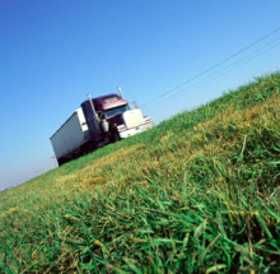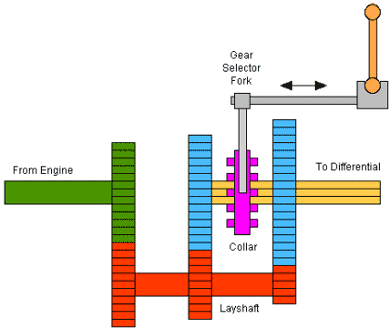Floating, Just Tried It Out, Seems Easier
Topic 10199 | Page 1
Double clutch in school, for your dmv test, any company road test, and then forget it's there unless taking off from a dead stop. Don't know how reliable this is, because my ex was certifiably crazy, but an excellent mechanic. He said not floating the gears (aka using the clutch unnecessarily) would cause a lot of needless wear and tear on the clutch and he didn't want to have to replace it. His brother (not crazy) said the same thing and didn't want me using the clutch in any of our trucks.
I learned on a 425 cat with an 18 speed split fuller transmission and absolutely floating gears was smooth and oh so easy. I didn't care for the super 10s at all but never had much experience with them as we didn't have any.. just drove relief for a friend for a few hours while he kicked back in the jump seat, and his truck had one. ;-)
Ooh I'm going to so love being back in a truck! It's been way too long ago.
Floating Gears:
An expression used to describe someone who is shifting gears without using the clutch at all. Drivers are taught to "Double Clutch" or press and release the clutch twice for each gear shift. If you're floating gears it means you're simply shifting without using the clutch at all.
Double Clutch:
To engage and then disengage the clutch twice for every gear change.
When double clutching you will push in the clutch, take the gearshift out of gear, release the clutch, press the clutch in again, shift the gearshift into the next gear, then release the clutch.
This is done on standard transmissions which do not have synchronizers in them, like those found in almost all Class A trucks.
Dm:
Dispatcher, Fleet Manager, Driver Manager
The primary person a driver communicates with at his/her company. A dispatcher can play many roles, depending on the company's structure. Dispatchers may assign freight, file requests for home time, relay messages between the driver and management, inform customer service of any delays, change appointment times, and report information to the load planners.DMV:
Department of Motor Vehicles, Bureau of Motor Vehicles
The state agency that handles everything related to your driver's licences, including testing, issuance, transfers, and revocation.
Hahaha yep them big arse clutches, ain't all that fun replacing !!

I can hop in any truck and drive it perfect. And never use the clutch.
Pick/Grin's question is:
why exactly is it taught that double clutching is "right"?
Let me take a stab at the reason you "need" to double clutch. Manual transmissions in passenger cars & pickup trucks have synchromesh gears that help synchronize the shifting gears so that they will mesh.
"Big trucks" do not have the synchromesh. Also, the gears are more massive, and keep spinning at the same speed down there in their box, as you shift them around. So you need to have some way to get the gears moved without grinding the gear teeth away. Using "double clutch" you take the engine torque pressure off the gears so that they will easily move apart and then move back together in the new gear. The "clutch out" part of the shift uses the flywheel to slow one gear down so it will match the new gear it's going to. As a driver new to the big trucks, the shifting rhythm is new (well, ain't it?) and you'll be grinding/not getting the shift and messing up the tranny. So, the double clutch is easier to learn than floating gears. (No! Wait before you disagree!)
 floating gears
floating gears
[The flywheel is on the green shaft, the drive wheels are on the brown shaft.]
When you float gears , the clutch stays engaged so the moving gear will automatically be the right speed to match the new gear it's going to. However, when floating gears, the timing of the accelerator, and your moving the shift lever are way more critical than in double clutch. It will be way easier to lose your shift and have to almost stop before you can get back into gear again. There's enough going on for a new driver already, so don't float gears until you can be more relaxed.
Once you can manage your big truck so you do not feel you are going to crash into the car in front of you, then start floating gears like greased lightening.
Floating Gears:
An expression used to describe someone who is shifting gears without using the clutch at all. Drivers are taught to "Double Clutch" or press and release the clutch twice for each gear shift. If you're floating gears it means you're simply shifting without using the clutch at all.
Float Gears:
An expression used to describe someone who is shifting gears without using the clutch at all. Drivers are taught to "Double Clutch" or press and release the clutch twice for each gear shift. If you're floating gears it means you're simply shifting without using the clutch at all.
Double Clutch:
To engage and then disengage the clutch twice for every gear change.
When double clutching you will push in the clutch, take the gearshift out of gear, release the clutch, press the clutch in again, shift the gearshift into the next gear, then release the clutch.
This is done on standard transmissions which do not have synchronizers in them, like those found in almost all Class A trucks.
Double Clutching:
To engage and then disengage the clutch twice for every gear change.
When double clutching you will push in the clutch, take the gearshift out of gear, release the clutch, press the clutch in again, shift the gearshift into the next gear, then release the clutch.
This is done on standard transmissions which do not have synchronizers in them, like those found in almost all Class A trucks.
Errol, I changed the term "glide shifting" to "floating gears" in your explanation because we want to keep the terms consistent. I've never heard the expression "glide shifting" before but normally it's referred to as floating gears.
Floating Gears:
An expression used to describe someone who is shifting gears without using the clutch at all. Drivers are taught to "Double Clutch" or press and release the clutch twice for each gear shift. If you're floating gears it means you're simply shifting without using the clutch at all.

Oh, I'm in no rush to learn how to fly through gears without the clutch. I plan to practice a little bit each day, maybe 30 minutes in very light traffic on level ground. Thanks all for the replies!
It's really up to you on how you drive and there's a ton of threads which have great advice from the veteran drivers here. Me personally, I'll float up and double clutch down but it depends on the load, where I'm driving etc. Just don't get down on yourself thinking because you can't float every shift up and down all the time that you're doing something wrong. Especially in company trucks, depending on the condition can depend on how you have to drive it.
Double Clutch:
To engage and then disengage the clutch twice for every gear change.
When double clutching you will push in the clutch, take the gearshift out of gear, release the clutch, press the clutch in again, shift the gearshift into the next gear, then release the clutch.
This is done on standard transmissions which do not have synchronizers in them, like those found in almost all Class A trucks.

Well it's close to 101 K right now, so its new-ish. Practiced a little bit more on my way here, only a 40 mile drive, very little traffic. Was a piece of cake shifting in and out, and I have figured out where to hit the RPM's when double shifting down.
I know a lot of guys can't do it when they start out, but I feel like I'm doing really good as far as driving goes. I made it an hour early, will make it to the shipper an hour early, and even had time to eat a big breakfast and gab with my mother for a half hour. Today feels like a good day gentleman. My miles are down, but I won't let that bug me.
Shipper:
The customer who is shipping the freight. This is where the driver will pick up a load and then deliver it to the receiver or consignee.
New Reply:
New! Check out our help videos for a better understanding of our forum features

















Preview:








 TT On Facebook
TT On Facebook
Still very green, and I'm still prone to losing a gear every once in a while, but I tried floating gears through a 40mph area, really just moseying on over to this truckstop to shut down. I think it was Errol who mentioned that clutches do not radically affect shifts, and I typically (almost always) skip shifts anyway.
It didn't seem to be that much different, so long as I tapped the throttle before getting into neutral and only once did I have to double clutch after losing the window for the rpms.
So my question is, why exactly is it taught that double clutching is "right"? Some say it prevents wear, but if done right, it seems almost smoother. I ask because bumper to bumper traffic is gonna wind up blowing out my knee, and they're bad to begin with (skateboarding, dirt bikes, tripping on air). I still plan to clutch, but I figure it's always good to know the how's and why's.
Floating Gears:
An expression used to describe someone who is shifting gears without using the clutch at all. Drivers are taught to "Double Clutch" or press and release the clutch twice for each gear shift. If you're floating gears it means you're simply shifting without using the clutch at all.
Double Clutch:
To engage and then disengage the clutch twice for every gear change.
When double clutching you will push in the clutch, take the gearshift out of gear, release the clutch, press the clutch in again, shift the gearshift into the next gear, then release the clutch.
This is done on standard transmissions which do not have synchronizers in them, like those found in almost all Class A trucks.
Double Clutching:
To engage and then disengage the clutch twice for every gear change.
When double clutching you will push in the clutch, take the gearshift out of gear, release the clutch, press the clutch in again, shift the gearshift into the next gear, then release the clutch.
This is done on standard transmissions which do not have synchronizers in them, like those found in almost all Class A trucks.
OWI:
Operating While Intoxicated